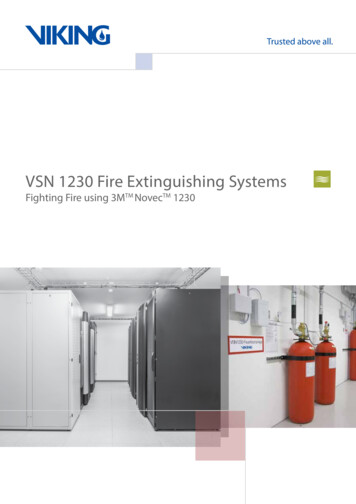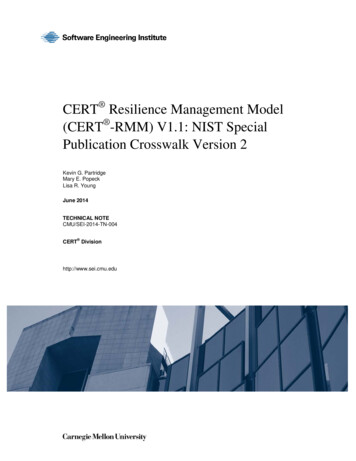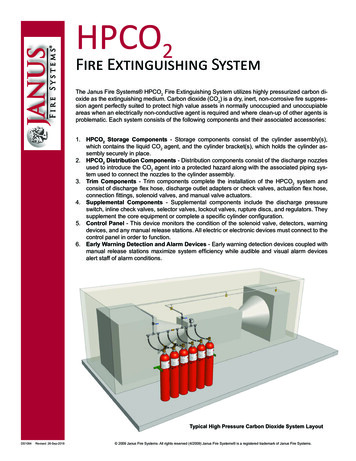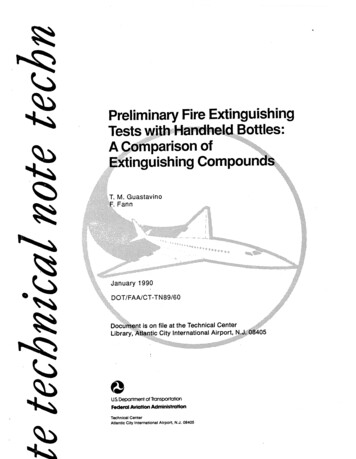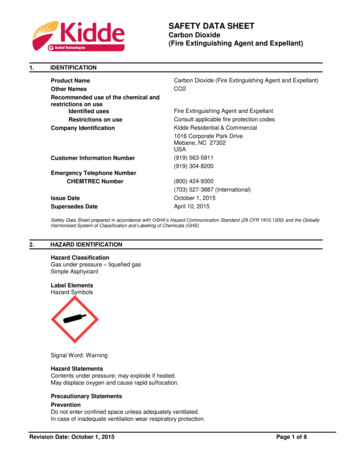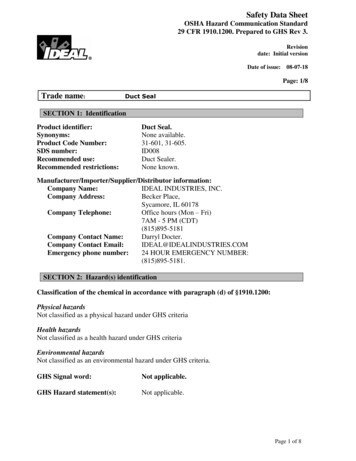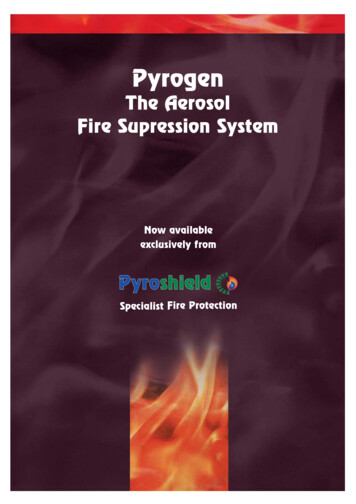
Transcription
FIRE-EXTINGUISHING POWDERSbyAnthony E. FinnertyU S . Army Research LaboratoryAberdeen Proving Ground, MD 21005-5066andLawrence J. Vande KieftFaith FarmStreet, MD 21 154-1 127ACKNOWLEDGMENTSThe authors are grateful for the financial support and continued consultation and encouragement fromMessrs. Steve McCormick and Mike Clauson of US. Army Tank Automotive Research, Development, andEngineering Center (TARDEC). Warren, MI. The U.S. Army is also indebted to them for their zeal anddedication to the search for and identification of appropriate substitute materials for Halon 1301 as a fireextinguishing agent.1. BACKGROUNDMany finely divided solids (nonflammable salts) have been used to quench hydrocarbon flames. Sodiumbicarbonate was widely used into the 1950s as the primary fm-extinguishing powder. The U.S. Navydetermined that potassium bicarbonate was superior to the sodium analog and subsequently changed its handheld extinguishers from sodium bicarbonate to potassium bicarbonate. Other solids, such as Monex, havebeen proposed, but their fire-extinguishing ability is only marginally superior to potassium bicarbonate.Because of the expense, there has been resistance to a changeover.It is widely believed that fireextinguishing powders can function as both energy-absorbing materials andsolid surfaces on which free radicals can be destroyed. Heat may be absorbed by the heat capacity of thesolid, the heat of fusion at the melting point, the heat capacity of the liquid, heat of dissociation frombreaking of chemical bonds, and heat of vaporization. All of these contribute to the total endothermicity ofthe fireextinguishing powder (ref. 1).From a chemical aspect (ref. 2.3). it has been found that potassium salts are more. effective than sodiumsalts, and iodide anions are more effective than chloride anions. Presumably, there is a catalytic path fordestruction of free radicals, such as H, 0, and OH, utilizing the potassium in the salts. It must beremembered that any powder that has a chemical fireextinguishing capability will also have a heat-absorbing(endothermic) capability.Ewing (ref. 1) has shown that less weight of salt per unit volume of a fuel-air mixture is required forextinguishment if the salt is finely divided. Large particles may actually pass through the flame zone beforethey can reach flame temperature and, thus, not absorb as much heat as an equivalent mass of finer particles.Another way to look at it is that the time required for small particles to become effective is less than that forlarge particles. Thus, micron-sized solids are more efficient as fire-extinguishing powders than are larger206Halon OptrmSTechniCal WO*wConference6-8 May 1997
particles. Large surface areas are important in both the heat absorption and the chemical interferencemechanisms.2. INTRODUCTIONIn many cases, there is a hesitation to use conventional fire-extinguishing powders, such as Purple K,Monex, and sodium bicarbonate, which can be corrosive to metals, especially aluminum. Therefore,aluminum oxide powder, which is chemically unreactive, has been chosen for aircraft applications. Thismaterial has no ability to melt, vaporize, or undergo bond-breaking at the temperatures encountered inhydrocarbon flames. Yet, tests have shown that aluminum oxide powder is effective in extinguishing fines,even though it only has the heat capacity of the solid to serve as its heat sink. This fact prompted a decisionto examine aluminum oxide powder in a scanning electron microscope (SEM) to determine if there wasanything unusual about this material.This, in turn,led to a decision to examine new types of micronized sodium bicarbonate powders that haverecently become commercially available. These powders have been proposed for use in engine compartmentsof combat vehicles. In order to complete this study, other common fire-extinguishingpowders have also beenexamined. Since the expense of full-scale testing of all of the powders under consideration would have beenprohibitive, a simple method of screening these powders for their effectiveness as fire-extinguishing agentswas needed. From the physics of fire extinguishment, the following parameters were selected: particle-sizedistribution, degree of agglomeration, and appearance (amorphous or crystalline). The materials that wereevaluated are. all currently accepted fire-extinguishing agents and, therefore, possess the quality, in variousdegrees. of endothermicity; obviously, they are also acceptable from the standpoint of toxicity. Interpretationof SEM and optical microscopy photographs was employed as the screening method in this study.Obviously, powder fireextinguishing agents are not suitable for use in occupied (crew) spaces; however,they may find utility in unoccupied compartments (e.g. engine compartments). Even in this application,toxicity is of concern, and only recognized fire-extinguishing agents would be applicable.It may be possible to use sprays of salt, dissolved in water, to obtain the effectiveness of a powder fireextinguishing agent, but delivered as a liquid spray. Only in a flame zone, where the water would bevaporized from the droplets, would the powder salt be formed. This approach could allow the use of highsalt, water-based sprays as very efficient fire-extinguishing agents.3. DESCRIPTION OF EXPERIMENTS3.1 Samules. Thiieen types of fire-extinguishing powders were available for testing. Eight weresamples of sodium bicarbonate from various manufacturers. Table 1 gives some details about the powdersthat were evaluated.3.2 Samule Preparation for SEM Observation. The instrument used was an IS1 model Super III-A SEM.Cylindrical aluminum pedestals Y2 in x I/z in were used in this instrument for sample mounting. A small pieceof double-sticky tape was placed on the upper flat surface to accept the sample powder. The powder waslightly stirred to bring some of it up from beneath the surface, to promote a more representative sampleselection, and a small spatula was used to extract a very small amount of powder from the container. Thespatula was held a few centimeters above the pedestal and gently tapped until the desired amount of powderhad fallen onto the pedestal. The pedestal was in turn tapped m various places to distribute the powder moreHalon OplionsTechnicalWorking Conference6-8May 1997207
Table 1. Listing of Samples That Were InvestigatedPowder TypeDescriptionSourceAmerexSodium BicarbonateATCAnsul 50Sodium BicarbonateATCAnsul 5ocSodium BicarbonateATCArm & Hammer Baking SodaSodium BicarbonateK-MartDessicarb RegularSodium BicarbonateATCDXP Clone DessicarbSodium BicarbonateATCII BSC SiliconizedISodium BicarbonateIATCAluminum OxideFire-Extinguishing GradeAlcoa CompositesAluminum OxideAnhydrousPhaltz & BauerMonoammonium PhosphateLocal Fire DepartmentMAPbCondensation product of urea and' ATC - Aberdeen Test CenterMAP - Monoammonium Phosphateuniformly over the surface area. The sample was then sputtered with a gold-palladium alloy for 2 min at 15pa current and 75-pm Hg pressure to ensure uniform conductivity and to prevent sample charging duringexposure to the electron beam. The sample, prepared in this manner, was then inserted into the SEM sampleholder and photographed at several magnifications. Operator bias can enter the procedure here in the choiceof sample region to study and analyze; therefore, the two methods, SEM and optical microscopy, wereemployed.3.3 Sample Preuaration for Optical Microscopv. Optical photo microscopy was also done on all of thepreviously mentioned samples, using a Nikon Optiphot binocular optical microscope. The microscope slideswere cleaned and then coated with a very thin film of silicone grease. The grease was necessary to keep thepowder in place on the slides during handling and observation. A small quantity, approximately 1 g of thepowder as received, was placed into an evaporating dish, and a stream of air was directed onto it from anatomizing squeeze bulb. The aerosolized powder was allowed to fall onto the microscope slide. Care wastaken to ensure that the microscope slide was approximately in the center of the footprint of the fallingpowder. To avoid observational bias. each slide was observed in the microscope at the same five coordinatelocations (Figure 1).208Halon OBlons Technl alWor*lng Conlerence6-8 May 1997
1.-c0 2-.E0M0E111aVL0111u0b-a0czNXmNNXmm22XmXm
dXdHalon OptioniTechnical Working Conference6-8 May 199721 1
21 2Halon Options Technical Wohlng Conlereence6-8 May 1997
Halon O t i n T e hWorkingn i a l Conference6-8 May 199721 3
large particle is an anomaly, not representative of the BSC siliconized sodium bicarbonate sample. ThePurple K, however, with a maximum characteristic dimension of 109 pm had many large particles.The powder with the smallest average characteristic dimension was the fire-extinguishing grade ofaluminum oxide. Its average (characteristic dimension) was 12 pm. The only other powder with an averagecharacteristic dimension under 20 pm was Ansul 5OC, with a value of 17 pm.The traditional fireextinguishing powders, MAP (31 pm), Monex (32 pm). and Purple K (35 pm) hadlarger characteristic dimensions than most of the sodium bicarbonate powders. All the sodium bicarbonatefire extinguishing powders except the BCS (32 pm) had average characteristic dimensions of 25 pm or less.As would probably be expected, the Arm & Hammer Baking Soda (sodium bicarbonate) and theanhydrous aluminum oxide had relatively large, average characteristic dimensions of 42 pm and 39 pm,respectively. Small particle size is not a requirement for these powders.5 . DISCUSSIONNeither optical nor SEM techniques provide the “better” data; they complement each other. The SEMphotos yield a better view of surface texture than can be seen on the optical photos. Yet, there is a goodchance the operator’s attention will be d m w to interesting parts of the field of view in the cathode ray tube.Thus, the SEM results may not be truly representative of the powder, since there is operator input in decidingwhat to emphasize.It was relatively easy to make the optical data free of bias by observations of predetermined sections ofthe microscope slides. T h i s approach was not true of the SEM data.An advantage of the optical analysis was a limited number of particles above dust size. This allowedmeasurements of every particle (excluding dust). In general, there was no overlap of particles on the slides,in contrast to a great deal of overlap of particles in the SEM photos.In many cases, there were significant differences in the characteristic dimension of the median particlesize from SEM and optical data. It is felt that the optical data is more reliable, since it does not involveoperator judgement in selecting the site to be evaluated. It was also found to be quite difficult to pick themedian particle size from the SEM photos, since there were many overlapping particles in the photos.It is felt that the fire-extinguishing effectiveness of the MAP, Monex. and Purple K powders could beenhanced if their average characteristic dimensions were as small as that of most of the sodium bicarbonatefireextinguishing powders. It is possible, in the case of Monex, that what was observed on the optical photoswas a small number of clumps of particles. If true, these clumps might break up upon activation of a fireextinguisher. It was noted, by examining Material Safety Data Sheets (MSDSs), that Ansul 50 containsdouble the dryiing agents that Monex has. An increase in the amount of drying agent may prevent clumpingof the Monex.The fireextinguishing grade of aluminum oxide with the smallest average characteristic dimension of12 pm is used in powder panels. In this application, the powder is released at the fuel source, which is thefire site. Thus, the smallest particles are not required to bavel through the air from a pressurized extinguisherto the fire site. Large aerodynamic drag on small particles is not a problem when powder panels are used.However, when fireextinguishing particles are released from a pressurized extinguisher and must travelthrough several feet of air to the fire site, aerodynamic drag is important. The optimal size of the particlesis a function of both the aerodynamic drag and the surface area presented to the fire. This value of theaverage characteristic dimension will have to be determined for individual applications.214t i a m opi ons ecnnlcaiwomng cmierowe6.8 M 1997Y
CONCLUSIONSThe following conclusions were drawn.(1) All of the sodium bicarbonate fire-extinguishing powders, with the possible exception of the BSCsiliconized sodium bicarbonate, are similar enough in particle size that particle size should not be anissue.(2) Even powders that must be driven through the air can have characteristic dimensions of 25 p m or less.(3) Manufacturers of fire-extinguishing powders should produce agents with small (25 pm or less)characteristic dimensions.(4) Large amounts of drying agents (8 to 10%) may be required to ensure good flow characteristics andabsence of clumping in fire-extinguishing powders that normally tend to absorb water.( 5 ) Powders that do not have to be driven through air (aluminum oxide in powder panels) can bemanufactured with very small characteristic dimensions (12 pm).REFERENCES1. Ewing, C. T., J. T. Hughes, and H. W. Carhart. Fire and Materials, vol. 8 , p. 148, 1984.2. Dolan, J. E. Sixth Symposium on Combustion, p. 787, Reinhold, NY, 1956.3. Altman, R. L., A. C. Teng, L. A. Mayer. and D. J. Myronuk. “Development and Testing of DryChemicals in Advanced Extinguishing Systems for Jet Engine Macelle Fires.” Report JTCG/AS-82-T002, 1983.Halon OpllonsTechnlcalWahlng Conference6-8May 1997215
FIRE-EXTINGUISHING POWDERS by Anthony E. Finnerty US. Army Research Laboratory Aberdeen Proving Ground, MD 21005-5066 and Lawrence J. Vande Kieft . If true, these clumps might break up upon activation of a fire extinguisher. It was noted, by examining Material Safety Data Sheets (MSDSs), that Ansul 50 contains
